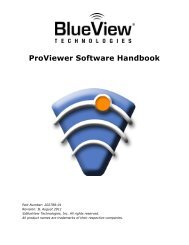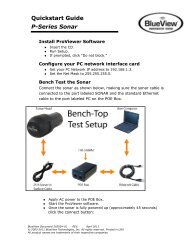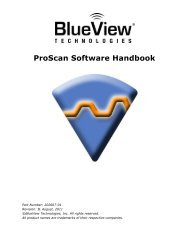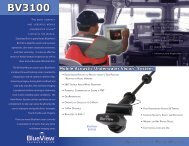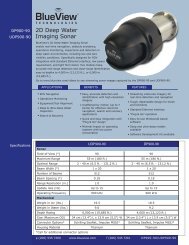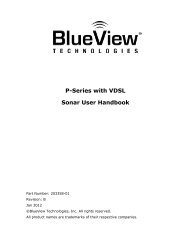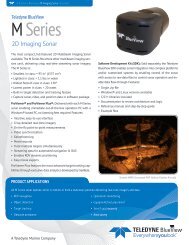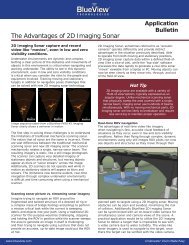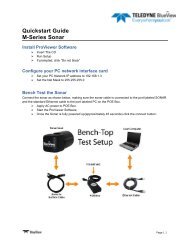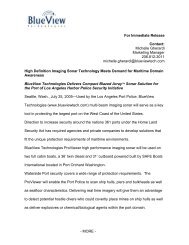Jane's Navy International Features BlueView
Jane's Navy International Features BlueView
Jane's Navy International Features BlueView
Create successful ePaper yourself
Turn your PDF publications into a flip-book with our unique Google optimized e-Paper software.
Mine warfare sonarSEA: 1330885resolution acoustic images as well as co-registeredbathymetry. HISAS 1030 and HUGIN1000 have been developed in parallel by thesame team and are optimised for each other.The sonar is tightly integrated with the HU-GIN aided inertial navigation and motionsensing platform and has a resolutionof 2-5 cm both alongand across track. HISAShas a range of up to200 m to each side at4 kt, and 260 m at 3 kt,contributing to an effectivearea coverage ratehigher than 2 km 2 /h. Datais recorded at a rate ofabout 60 Gbit/h onto a detachableRAID system for post-processing onboard the surface vessel.For bathymetry, HISAS 1030 has two fulllengthreceive arrays on each side of the HU-GIN to form two SAS images of the samescene with slightly different geometry, enablingvery-high-resolution interferometric processingfrom SAS data. Typical SAS bathymetryresolution is 10x10 cm, allowing 3-D imagingof mines and mine-like objects. HISAS 1030also has a steerable phased-array transmitter,which can be optimised to avoid multipathand hence extend the range in shallow water.Full-quality HISAS imaging is typically availableout to a range of 10 times UUV altitude inshallow and very shallow water.A full-capability HUGIN MRS, incorporatinga HISAS 1030 high-resolution interferometricSAS, was delivered to the RNoN inMarch 2008 to undertake rapid environmentalassessment, high-precision seabed route surveysand mine detection, classification andlocalisation. HUGINs fitted with the HISAS1030 will also equip the Finnish <strong>Navy</strong>’s threenew MCMV 2010 ships.Ultra Electronics’ ARTEMES high-resolutionSAS system, featuring co-located highresolutionswath bathymetry and side-scanimagery, has been developed for high-speedcoverage for mine detection and is also capableof being operated from UUVs and unmannedsurface vehicles. One concept considered forfuture mine warfare operations is the integrationof ARTEMES with the SeaFox mine-disposalsystem in an unmanned underwater vehicle,enabling a single asset to deliver an integratedmine-detection and -disposal capability. ART-EMES is available in frequencies up to 360 kHzand is in service with a United States-basedclient, with six systems operational.Ultra has also developed a Mini-SAS tri-frequency(273 kHz, 310 kHz and 247 kHz) systemspecifically for use with mid-sized 12-inchUUVs. Making use of wideband pulse compressionwith long-transmit pulses and theThe Bluefin-21 AUV, equipped with ThalesUnderwater Systems’ synthetic aperture sonarmodular payload section.Ultra Versatile Sonar Architecture, Mini-SASaims to provide concurrent side-look withmulti-aspect forward and aft ‘squint’ looks toaugment detection and classification survey.An optional bathymetric capability, to fullSAS resolution, can also be included. Mini-SAS has been demonstrated in very-shallowwateroperations providing SAS and seabedbathymetry coverage at slant ranges in excessof 10:1 of the sonar altitude.Forward Look SonarAnother complementary development isUltra’s VSS Forward Look Sonar (FLS), designedto be configured as a gap-filling sonar,an obstacle avoidance sonar, and as a standaloneforward-look detection and classificationsonar, operating at centre frequencies from60 kHz to 450 kHz. Orthogonal pulses arecombined in the processing to increase theeffective physical aperture length in order toimprove the resolution of the system.Small independently sampled elements unambiguouslysample the full sector of interestforming sector widths of up to ±75 degreesusing a curved transmitter array. Bathymetryis obtained from wideband processing of thebeam-formed data to generate a 3-D imageover the full-range swath from each ping.The FLS is also available in a dual-frequency75 kHz/300 kHz version. It can also form partof a combined system with the SAS system.The first delivery to a US client was due to becompleted in early 2009.The PSU/ARL SAS installed on the Bluefin-12UUV – SAS-12 – operates at 180 kHzin the side-looking mode. A suite of arbitrarywaveforms can be transmitted to optimiseSAS performance in a given environment. Thebroadband receiver is designed for minimalThe SWATHplus-RS100 sonar fitted to the front end of the REMUS 100 UUV.Jane’s/IDR: 1184777channel-to-channel gain and phase errors necessaryfor acquisition of high-fidelity signals.Signals are filtered and decimated then passedto the recorder and processing systems. Theindividual element aperture determines theultimate resolution limit. In principle, SAS-12can be processed for 25 mm resolution at allranges out to a maximum of 150 m.Another Bluefin-21 UUV fitted with an SASwas that acquired by Thales Underwater Systemsas part of the MUSCLE technologydemonstrator system built for the NATO UnderseaResearch Centre (NURC) at La Spezia,Italy. The MUSCLE SAS is a 300 kHz widebandinterferometric SAS optimised for shallow-waterminehunting; it consists of tworeceiver arrays with different vertical fields ofview, each appropriately narrowed to rejectmultipath but steered in different directions soas to cover almost all the full swath. The verticalreceive element comprises upper and lowerarrays made up of 19 and 10 vertical sub-elementsrespectively. The sub-elements are connectedby a shading capacitor-resistor networkthat allows a degree of flexibility, by hardwaremodification, in forming the vertical-beampattern of both arrays. The MUSCLE SASsystem has 13 beams spaced 4 cm apart. It wasplanned to implement onboard SAS processingresolution up to 2.5 cm at 225 m.MUSCLE is being used to demonstratehigh resolution at extended ranges, improvedhighlight data (to enhance classification performance)and increased search rates. Acceptancetesting began at La Spezia in May 2006.A trial conducted by NURC in June 2006demonstrated imaging with shadow contrastin excess of 5 dB at up to 170 m range in 20 mwater depth, with resolutions of 1.6 cm inrange and 5 cm in cross-range.SAS is regarded by NURC as a powerfulenabler towards achieving reliable ATR. Researchat NURC is addressing ATR algorithmsto complement SAS/high-resolution data(these include model-based techniques, adaptiveapproaches to cope with environmentalchanges and online learning algorithms) andthe use of shape theory to support ATR performanceprediction.Although a number of multibeam swathsonars have been developed for surface craft,towed fish or larger UUVs, the challenge hasbeen to integrate this capability with the smaller,man-portable vehicles. One such developmenthas been the GeoSwath Plus, a PC-basedshallow-water (down to 200 m) swath bathymetrysystem from GeoAcoustics. The systemprovides swath coverage of up to 12 timeswater depth to a maximum of 600 m. It is believedthat the 500 kHz version has been fittedto the REMUS 100, Gavia and Talismanvehicles. This has a maximum swath width of150 m, a range of up to 12 times depth and aresolution slant range of 1.5 mm.Another system is the Sea (Group)SWATHplus-RS100 high-resolution bathymetryand side-scan sonar, purpose-designedfor the REMUS 100. This is a 468 kHz sonarfeaturing 1-3 composite transducer technologyand is supplied as a short (38 cm-long) sectionof the UUV. According to SEA, the SWATHplus-RS100has a swath width of up to 15times the vehicle altitude (maximum 75 m) to30 jni.janes.com n JANE’S NAVY INTERNATIONAL JUNE 2009



